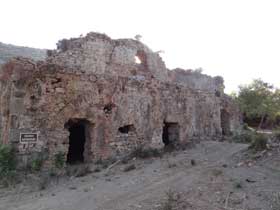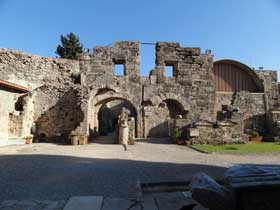 |
 |
|
|
|
The term thermal baths was used to describe larger public bathing establishments in the Roman Empire. The Latin term thermae - thermal baths - for large public baths spread at the end of the 1st century AD. The thermal baths were places of communication and pastime. Here people met, relaxed from the hustle and bustle of the city and the stress of the day. Thermal baths offered numerous services such as massages, gymnastics, manicures and beauty treatments. The thermal baths were heated by the hypocaust, a network of heated air pipes under the floor and in the walls, fired by slaves. Wealthy merchants cultivated or established contacts here and concluded business deals. Even the Roman emperors visited the thermal baths in order to be close to the people. Entry was cheap, but you had to pay extra for guarded cloakrooms, massages, etc. One wore a wrap around the hip, the subligaculum, for outdoor ball games also the tunic, women often wore a kind of bikini. For women there were originally separate baths, but even Cicero lamented the decline of morals, because the separation of the sexes was mostly disregarded; Hadrian introduced separate bathing times in shared bathing facilities, for women in the morning, for men in the afternoon, but in practice this was often not strictly followed. The thermal baths always had the same sequence of rooms as the Hellenistic baths: In the apodyterium, the changing room, people undressed and stored their clothes in the lockable niches embedded in the wall, the loculi, or gave them to their slave or the capsarius (slave who guards the clothes) for storage. While in Greece they did sports and bathed naked, in Rome at least the women wore a kind of bikini. The temperature in the individual rooms probably corresponded to that in the Turkish hammam, as also the sequence of the bathing procedure is described similarly. First one cooled down in the frigidarium, the cold bath room, and jumped there into the cold water basin. The frigidarium was the largest room of the thermal baths and therefore probably the main lounge. In the Caracalla thermal baths in Rome, there were 1600 marble chairs on which one could sit and be watered with cold water. Here were also small basins (piscina). One cleaned oneself with the strigilis and after the bath in the aleipterion (Latin: unctuarium) one had oiled and massaged. The frigidarium of the Diocletian Baths has been preserved as a church until today. Attached to the frigidarium was the palaestra, the sports field, so that after physical exercise, such as ball games or muscle training with dumbbells, one could immediately refresh oneself in the cold water. In addition, large swimming pools offered a real swimming pool (natatio), some of which were even roofed, but which were only so deep that it was always possible to stand because only a few people were able to swim. This was followed by the tepidarium, also heated by hypocausts, with mild heat. The tepidarium usually did not contain a tank. It isolated the heated rooms from the cold ones and thus facilitated the adaptation. Afterwards one entered the caldarium, the hot bath room heated by hypocausts and wall heaters, mostly located to the south with hot water basin. The floor temperature there could easily exceed 50 °C, which is why wooden shoes were worn in the bathroom. In the caldarium there were mostly apses in which the baths filled with 40 °C hot water were located. While one enjoyed the view through the big windows, one could be showered with warm water by a slave. The Romans used both floor and wall heating with hot air (hypocaustum) in their thermal baths. Both techniques were initially developed and used for thermal baths. The heated rooms could look very different depending on the size and type of bath. What they had in common was that they were mostly south facing in order to use the warmth of the sun. Vitruvius recommended that the floor of the hypocaust should have a slight inclination so that the heat of the underfloor heating spreads better. The walls often consisted of hollow bricks, through which hot air was also conducted. In the Caracalla thermal baths, the caldarium (hot bath) was round and covered by a large dome. From the corridors under the actual bathrooms, slaves served the wall heating through numerous poker flaps, which were embedded in the pedestals of the main walls of the building. The working conditions in these corridors must have been appalling, as the smoke only gradually escaped through the ceiling holes. The heating chambers (praefurnia) were regularly supplied with charcoal by the slaves. Later one preferred as dry wood as possible. The hot air went up through the cavities and heated floors and walls. The heating had to be maintained day and night. The temperature could be varied by ventilation flaps in the roof. The heat of the Roman baths was almost always steam heat, with the exception of the laconicum, which was sometimes present and in which a dry heat prevailed. In this room it could be much hotter than in the traditionally heated caldarium, similar to a sauna, so the time spent here was shorter. |
|
|
|
|
|
Other Baths in preparation |
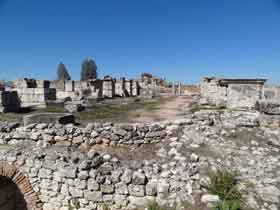 |
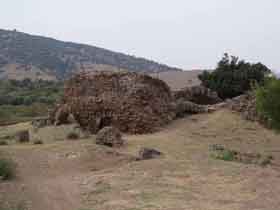 |
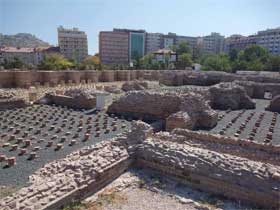 |
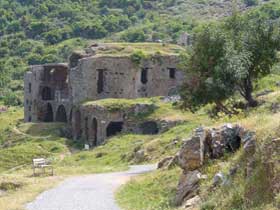 |
||||
| Aizanoi | Alabanda |
Ancyra (Ankara) |
Anemurium | ||||
|
The baths complex with adjoining Palästra is on the way to the stadium-theatre complex. It was built in the second half of the 2nd century AD. |
The central bath of is not yet excavated. It had like all Hellenistic and Roman baths a frigidarium and a caldarium. |
The Roman Baths of Ankara |
Large bath from the 3rd century AD were supplied with water by one of the two aqueducts until it collapsed. |
||||
| more: | more: | more: | more: | ||||
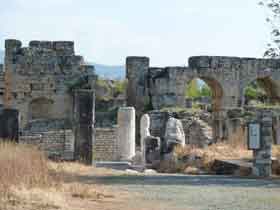 |
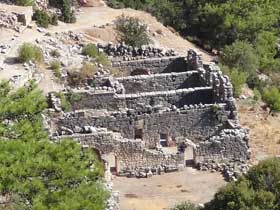 |
 |
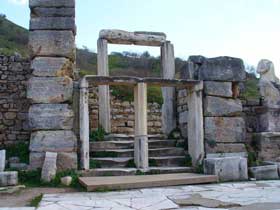 |
||||
| Aphrodisias | Arykanda | Aspendos | Ephesos | ||||
|
The large bathhouse in Aphrodisias was built at the beginning of the 2nd century AD and dedicated to the emperor Hadrian. |
Large bathhouse from the time of the Roman Empire, extended by a gymnasion in the 2nd century AD. |
Barely noticed, large Roman bathhouse south of the theatre. |
The Scholastika Bath |
||||
| more: | in preparation | more: | |||||
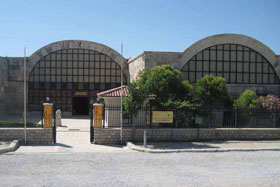 |
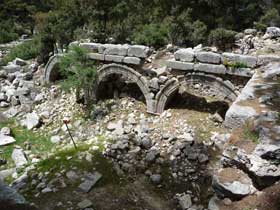 |
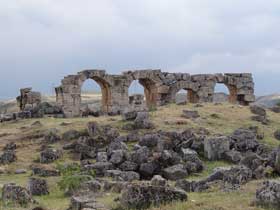 |
 |
||||
| Hierapolis | Kitanaura (Sarayçik) | Laodicea | Laodicea | ||||
|
The large Roman bath above the calcareous sinter terraces was built in the 2nd century BC. Today the museum is located here. |
Bathhouse below the Acropolis was built in the 3rd century AD and was in operation until the 14th century. | According to the inscription, the South bath was dedicated to Emperor Hadrian and his wife Sabina. It was built in 135 AD. |
The West bath Decoration on architrave friezes indicates a date of construction in the 2nd century AD. |
||||
| more: | more: | more: | |||||
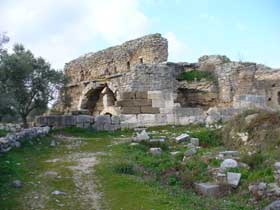 |
 |
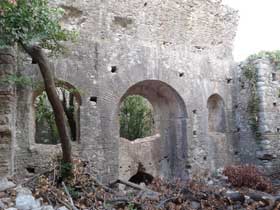 |
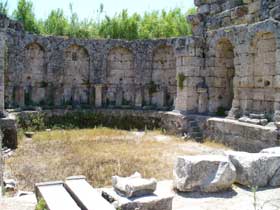 |
||||
| Milet | Olbia | Olympos | Perge | ||||
|
The Faustina Baths Donated and named after the wife of Emperor Markus Aurelius (161-180 A.D.) |
Roman Bathhouse |
The Vespasian bath |
The South Bath |
||||
| more: | more: | more: | more: | ||||
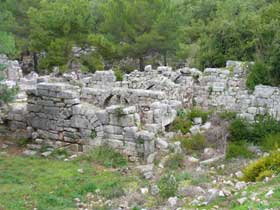 |
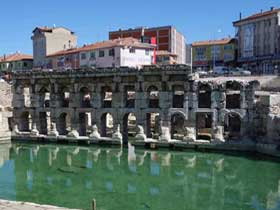 |
|
|
||||
| Phaselis | Sarikaya | Selinus | Side | ||||
|
The Theater bath in Phaselis, also called "small bath", is located on the east side of the central marketplace, below the theater. |
Today's Sarikaya was known in Roman times under the name Aqua Sarvenae. Only the thermal spa survived the many earthquakes. |
Selinus became Roman in 197 BC. With it a lively building activity began. The bathing complex probably dates from this period. |
Built in the 3rd century AD, the 60 x 40 metre Roman bath now houses the archaeological museum. |
||||
| more: | more: | more: | more: | ||||
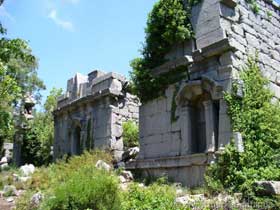 |
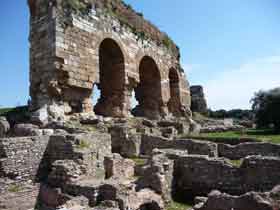 |
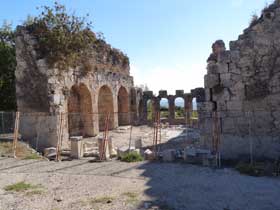 |
|||||
|
Termessos |
Tralleis |
Tlos |
|||||
|
The large Roman bathing and sports complex was part of an entire complex that was identified as a gymnasium. |
Approx. 25,000 square metres large bath gymnastics complex from the Roman imperial period. Destroyed by an earthquake in 26 BC. |
The large thermal spa in Tlos and the small one next to it form a bathing and sports complex and thus a spatial unit. |
|||||
| more: | more: | more: | |||||
|
Other Baths in preparation |
|||||||
